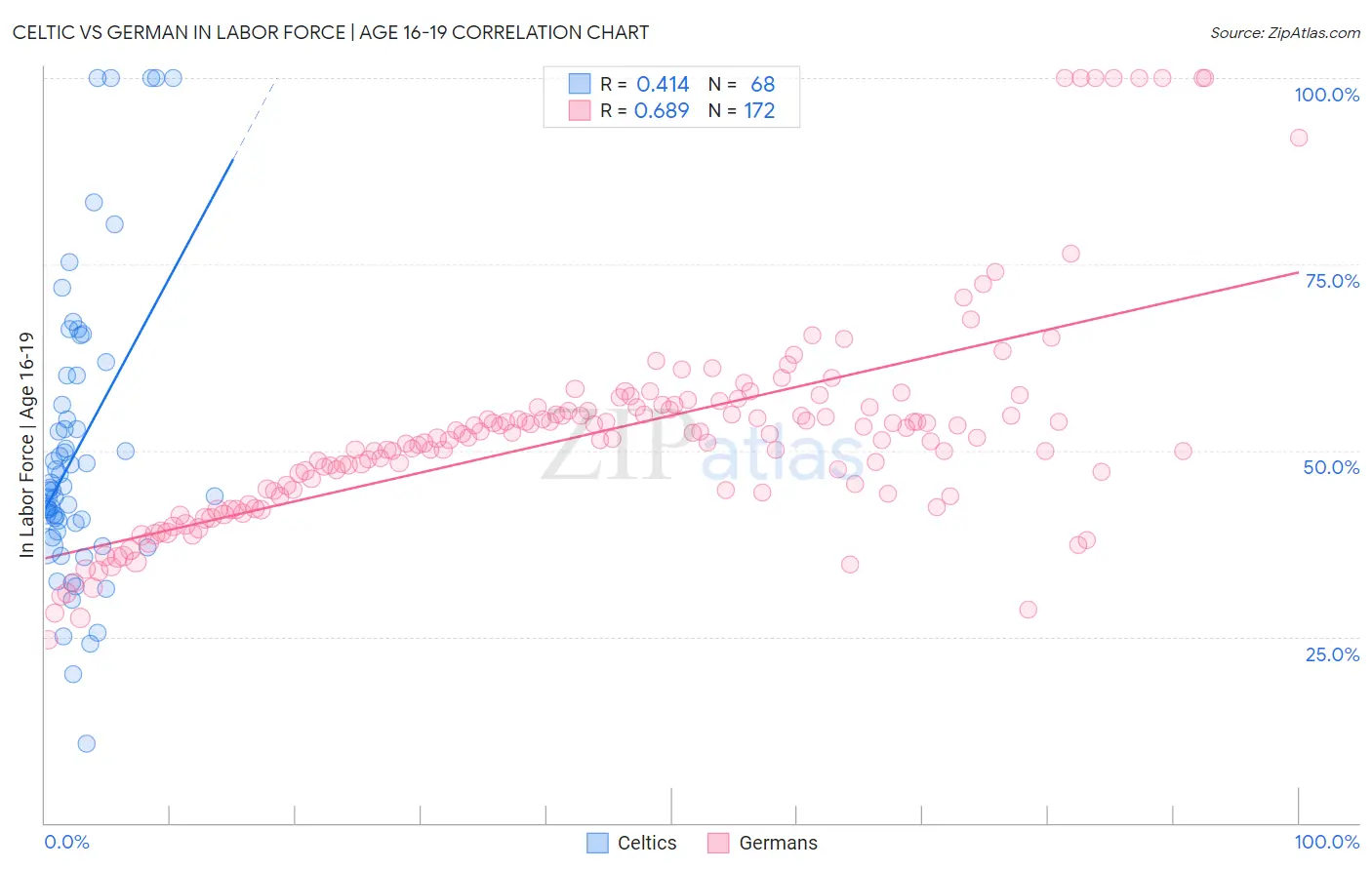Celtic vs German In Labor Force | Age 16-19
COMPARE
Celtic
German
In Labor Force | Age 16-19
In Labor Force | Age 16-19 Comparison
Celtics
Germans
41.3%
IN LABOR FORCE | AGE 16-19
100.0/ 100
METRIC RATING
41st/ 347
METRIC RANK
44.2%
IN LABOR FORCE | AGE 16-19
100.0/ 100
METRIC RATING
10th/ 347
METRIC RANK
Celtic vs German In Labor Force | Age 16-19 Correlation Chart
The statistical analysis conducted on geographies consisting of 168,748,134 people shows a moderate positive correlation between the proportion of Celtics and labor force participation rate among population between the ages 16 and 19 in the United States with a correlation coefficient (R) of 0.414 and weighted average of 41.3%. Similarly, the statistical analysis conducted on geographies consisting of 575,301,683 people shows a significant positive correlation between the proportion of Germans and labor force participation rate among population between the ages 16 and 19 in the United States with a correlation coefficient (R) of 0.689 and weighted average of 44.2%, a difference of 6.9%.

In Labor Force | Age 16-19 Correlation Summary
| Measurement | Celtic | German |
| Minimum | 10.6% | 24.6% |
| Maximum | 100.0% | 100.0% |
| Range | 89.4% | 75.4% |
| Mean | 50.1% | 52.2% |
| Median | 44.9% | 51.6% |
| Interquartile 25% (IQ1) | 39.6% | 44.2% |
| Interquartile 75% (IQ3) | 58.1% | 55.7% |
| Interquartile Range (IQR) | 18.5% | 11.4% |
| Standard Deviation (Sample) | 19.6% | 14.3% |
| Standard Deviation (Population) | 19.4% | 14.2% |
Similar Demographics by In Labor Force | Age 16-19
Demographics Similar to Celtics by In Labor Force | Age 16-19
In terms of in labor force | age 16-19, the demographic groups most similar to Celtics are White/Caucasian (41.3%, a difference of 0.010%), Tongan (41.2%, a difference of 0.31%), Immigrants from Liberia (41.5%, a difference of 0.34%), European (41.1%, a difference of 0.42%), and Scotch-Irish (41.5%, a difference of 0.44%).
| Demographics | Rating | Rank | In Labor Force | Age 16-19 |
| Immigrants | Bosnia and Herzegovina | 100.0 /100 | #34 | Exceptional 41.8% |
| Yugoslavians | 100.0 /100 | #35 | Exceptional 41.8% |
| Immigrants | Azores | 100.0 /100 | #36 | Exceptional 41.7% |
| Immigrants | Congo | 100.0 /100 | #37 | Exceptional 41.7% |
| Sioux | 100.0 /100 | #38 | Exceptional 41.5% |
| Scotch-Irish | 100.0 /100 | #39 | Exceptional 41.5% |
| Immigrants | Liberia | 100.0 /100 | #40 | Exceptional 41.5% |
| Celtics | 100.0 /100 | #41 | Exceptional 41.3% |
| Whites/Caucasians | 100.0 /100 | #42 | Exceptional 41.3% |
| Tongans | 100.0 /100 | #43 | Exceptional 41.2% |
| Europeans | 100.0 /100 | #44 | Exceptional 41.1% |
| Croatians | 100.0 /100 | #45 | Exceptional 41.1% |
| Immigrants | Sudan | 100.0 /100 | #46 | Exceptional 41.0% |
| Carpatho Rusyns | 100.0 /100 | #47 | Exceptional 40.8% |
| Icelanders | 100.0 /100 | #48 | Exceptional 40.8% |
Demographics Similar to Germans by In Labor Force | Age 16-19
In terms of in labor force | age 16-19, the demographic groups most similar to Germans are Swedish (44.1%, a difference of 0.080%), Finnish (43.9%, a difference of 0.54%), Dutch (43.8%, a difference of 0.73%), Cape Verdean (44.5%, a difference of 0.74%), and Chippewa (43.8%, a difference of 0.83%).
| Demographics | Rating | Rank | In Labor Force | Age 16-19 |
| Immigrants | Somalia | 100.0 /100 | #3 | Exceptional 45.6% |
| Luxembourgers | 100.0 /100 | #4 | Exceptional 45.3% |
| Alaskan Athabascans | 100.0 /100 | #5 | Exceptional 45.2% |
| Somalis | 100.0 /100 | #6 | Exceptional 45.1% |
| Danes | 100.0 /100 | #7 | Exceptional 44.7% |
| Immigrants | Cabo Verde | 100.0 /100 | #8 | Exceptional 44.7% |
| Cape Verdeans | 100.0 /100 | #9 | Exceptional 44.5% |
| Germans | 100.0 /100 | #10 | Exceptional 44.2% |
| Swedes | 100.0 /100 | #11 | Exceptional 44.1% |
| Finns | 100.0 /100 | #12 | Exceptional 43.9% |
| Dutch | 100.0 /100 | #13 | Exceptional 43.8% |
| Chippewa | 100.0 /100 | #14 | Exceptional 43.8% |
| Slovenes | 100.0 /100 | #15 | Exceptional 43.7% |
| Czechs | 100.0 /100 | #16 | Exceptional 43.6% |
| Scandinavians | 100.0 /100 | #17 | Exceptional 43.6% |